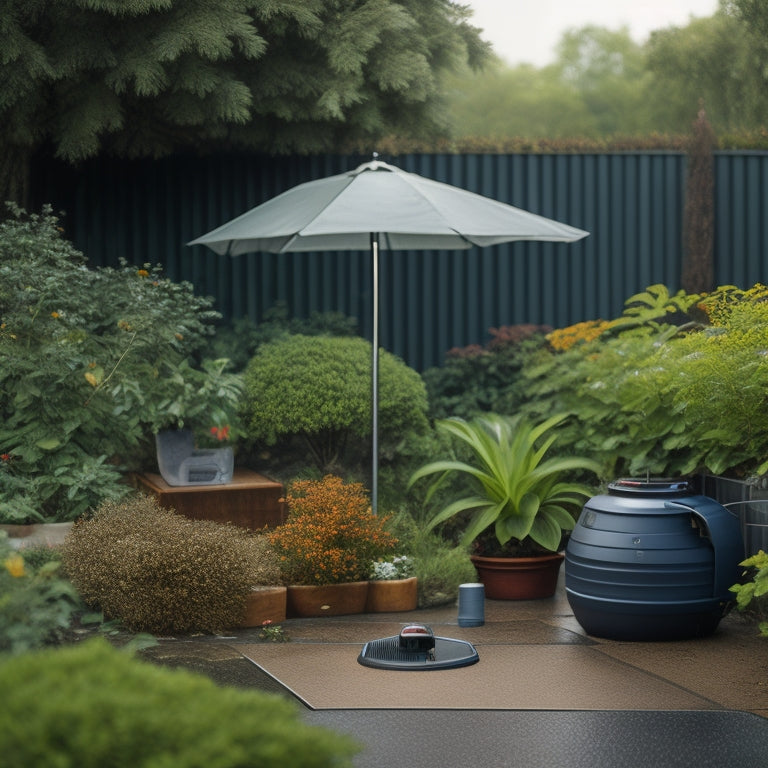
Rainwater Tank Size: Calculate Your Perfect Capacity
Share
To calculate your perfect rainwater tank size, you'll need to determine your household's average daily water needs, considering seasonal variations and peak demand periods. Next, calculate your roof catchment area, accounting for obstructions and material type, and estimate your runoff coefficient value, which ranges from 0.7 to 0.9 depending on factors like roof slope and vegetation. Then, apply a tank sizing formula that incorporates these factors, as well as tank material and installation considerations. By accurately evaluating these variables, you'll be well on your way to determining the ideal tank capacity for your specific needs, and a reliable water supply will soon be within reach.
Key Takeaways
- Calculate the roof catchment area accurately, considering obstructions and material type, to determine the ideal tank capacity.
- Apply the runoff coefficient value, typically between 0.7 and 0.9, to account for roof material, slope, and vegetation effects.
- Consider seasonal variations and peak demand periods to ensure the tank size accommodates the highest usage periods.
- Factor in water demand for various uses, such as household requirements, to determine the optimal tank size and refill rates.
- Choose the right tank material, considering durability, corrosion resistance, and lifespan, to meet your rainwater harvesting needs.
Determining Your Water Needs
When sizing a rainwater tank, determining your water needs is an essential step.
You'll want to calculate your average daily rain usage to guarantee your tank can meet your demands. Consider your household's water requirements, including drinking, cooking, washing, and irrigation.
Additionally, factor in seasonal variations, as your needs may fluctuate throughout the year. For example, you may use more water during summer for gardening or pool maintenance.
Furthermore, just like fast charging infrastructure reduces downtime, a well-sized rainwater tank minimizes the risk of water scarcity.
Take note of your highest usage periods to determine your peak demand. This information will help you determine the minimum tank size required to meet your needs, assuring you have a reliable source of water when you need it most.
Roof Catchment Area Calculation
Beyond your household's water needs, the roof catchment area plays an essential role in determining the ideal rainwater tank size. This is because the roof serves as the primary collection point for rainwater harvesting. To calculate the roof catchment area, you'll need to determine the square footage of your roof. Consider the size and shape of your roof, as well as the roof materials used. Different materials, such as asphalt shingles or metal roofing, can affect the runoff coefficient value.
| Roof Material | Effective Collection Area |
|---|---|
| Asphalt Shingles | 0.85 |
| Metal Roofing | 0.95 |
| Clay Tiles | 0.80 |
| Concrete Tiles | 0.75 |
| Green Roof | 0.50 |
Remember to account for any obstructions, such as skylights or vents, when calculating your roof's effective collection area. This will guarantee you get an accurate estimate of your roof's rainwater harvesting potential.
Calculating Runoff Coefficient Value
Calculating Runoff Coefficient Value
Most roofs have a runoff coefficient value between 0.7 and 0.9, which signifies the proportion of rainfall that actually becomes runoff. You'll need to determine this value to accurately calculate your rainwater tank size.
The runoff coefficient accounts for factors like roof material, slope, and surrounding vegetation, which affect runoff variations. For instance, a smooth, impervious surface like a metal roof will have a higher runoff coefficient than a rough, permeable surface like a thatched roof.
Consider your local rainfall patterns and roof characteristics to estimate this value. A higher coefficient means more rainfall becomes runoff, while a lower coefficient indicates more rainfall is absorbed or evaporated.
Hybrid electric solutions reducing emissions can also contribute to a cleaner environment, and understanding the runoff coefficient is essential in achieving sustainable practices.
Storage Tank Sizing Formula
With your runoff coefficient value in hand, you can now apply it to the storage tank sizing formula to determine the ideal capacity for your rainwater harvesting system.
The formula takes into account the roof's surface area, rainfall intensity, and tank material. For a sustainable approach, consider integrating renewable energy sources into your rainwater harvesting system to reduce your carbon footprint.
Additionally, incorporating green roofs and solar panels into your design can further enhance the eco-friendliness of your system.
For a rectangular tank, the formula is:
Tank Capacity (liters) = (Roof Area x Runoff Coefficient x Rainfall Intensity) / (Tank Material x Installation Tips).
Plug in your values to get an accurate estimate of the tank size you need.
Keep in mind that the tank material and installation tips can greatly impact the overall capacity. For instance, a steel tank may require a larger capacity than a concrete tank due to its material properties.
Factors Affecting Tank Capacity
Your rainwater harvesting system's tank capacity is influenced by several factors that go beyond the storage tank sizing formula. These factors can greatly impact the overall performance and efficiency of your system.
| Factor | Description | Impact on Tank Capacity |
|---|---|---|
| Roof Catchment Area | Size of the roof collecting rainwater | Increases tank capacity needs |
| Tank Materials | Material durability and resistance to corrosion | Affects tank lifespan and capacity |
| Seasonal Variations | Changes in rainfall patterns throughout the year | Influences tank size and overflow management |
| Water Demand | Amount of water required for irrigation, toilet flushing, etc. | Impacts tank size and refill rates |
| Climate and Region | Local rainfall patterns, temperature, and humidity | Affects tank size, material choice, and system design |
These factors must be carefully considered when calculating your ideal tank capacity to guarantee a reliable and efficient rainwater harvesting system.
Frequently Asked Questions
Can I Use a Rainwater Tank for Drinking Water?
You can use a rainwater tank for drinking water if you implement proper rainwater filtration, ensuring it meets health standards, like NSF/ANSI 61, to guarantee safe consumption, giving you autonomy over your water supply.
How Often Should I Clean My Rainwater Tank?
You'll want to prioritize tank maintenance, cleaning your rainwater tank every 3-6 months to prevent sediment buildup and bacterial growth, ensuring a clean and safe water supply that gives you the freedom to live off the grid.
Can I Connect Multiple Tanks for Increased Capacity?
You can connect multiple tanks to enhance your storage capacity, exploring various tank configurations to optimize your capacity and meet your unique needs, ensuring a reliable water supply that liberates you from municipal dependencies.
Do Rainwater Tanks Attract Mosquitoes and Other Pests?
Like a guide, your rainwater tank can attract unwanted guests, but you can outsmart them. You'll need a solid mosquito prevention strategy, incorporating pest control measures like screens, tight-fitting lids, and regular cleaning to keep your water storage haven pest-free.
Are Rainwater Tanks Suitable for High-Rise Buildings?
You're wondering if rainwater tanks are suitable for high-rise buildings; they can be, but you'll need to take into account tank installation constraints, such as weight and space, and comply with urban regulations regarding rooftop water storage and safety.
Related Posts
-

7 Best Cool Roof Rebates for Energy-Savvy Homeowners
You're an energy-savvy homeowner looking to install a cool roof, and you're wondering which rebates can help you save...
-

How to Upgrade Your Home With Geothermal Innovations
You're now on the cusp of utilizing the Earth's natural thermal energy to revolutionize your home's heating and cooli...
-

7 Top HEPA Filters for Green Building Projects
You need a reliable HEPA filter for your green building project that aligns with your sustainable goals and guarantee...


